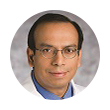Imagine a tiny fastener repairing a leaky valve. Now imagine that little fastener being placed inside your heart.
A breakthrough innovation using such a device is making it possible for more people with something called mitral valve regurgitation to be treated with a minimally invasive procedure – rather than undergo open heart surgery to repair or replace the valve.
How Does the Mitral Valve Work?
You probably know your heart pumps blood through its chambers and into the body. But did you know heart valves keep blood flowing in the right direction? That’s what the mitral valve does. It moves oxygen-rich blood from the left atrium into the left ventricle. The mitral valve’s two leaflets open and close quickly to allow blood to move forward while preventing it from escaping backward into the left atrium.
Why Does the Heart Valve Leak?
Sometimes the leaflets don’t close completely. This can occur when special chords which attach the leaflets to your heart muscle stretch or become ruptured. When that happens, the valve leaks and lets blood flow backward. This is called mitral regurgitation. It can be mild to severe and symptoms include:
- Heat murmur
- Shortness of breath
- Fatigue
- Lightheadedness
- Cough
- Heart palpitations
- Swollen feet/ankles
- Excessive urination
Sometimes, the mitral valve is pulled apart and leaks from the center. Called secondary mitral regurgitation, this happens in people with atrial fibrillation, heart failure or other heart conditions.
How is the Leaky Heart Valve Fixed?
Treatment options for MR traditionally included medication for mild cases and open heart surgery for more severe MR. More recently, a minimally invasive procedure was developed which involves implanting a special device in the leaky portion of the mitral valve.
It works like this:
- A small puncture is made in the femoral artery in the groin
- A tiny wire is guided to the heart and into the chamber near the mitral valve
- The special device is delivered over the wire to the valve
- Using imaging technology, the precise location of leakage is determined
- The device, which resembles a clip or a staple, is attached to the valve
- Leakage is eliminated or minimized
Benefits of the Procedure
The benefits of the procedure include a shorter hospital stay and improved quality of life, and improved survival, all without the need for undergoing open heart surgery. This device was the first the FDA had approved in 2013 for patients with primary mitral regurgitation where there is primary defect with the leaflets of the valve due to excess tissue, loose or ruptured support or thickened leaflets. In March of 2019, the FDA approved this treatment approach for secondary mitral regurgitation patients who are too high risk for surgery. That means more people than ever before can take advantage of this technology.
Contact a CHI Health Cardiologist for more information.





